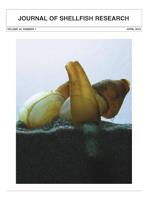Among the challenges facing aquaculture of native species are potential negative effects of gene flow from cultured to wild populations. Estimates of gene flow are based in large part on the capacity for gamete exchange between individuals, and make estimates of reproductive output and timing of gametogenesis in adjacent cultured and wild populations important to assess. Farmed geoducks of known age from each of five year classes and from nearby wild populations were sampled for reproductive development and other morphometric parameters in March, April, and May 2007 from three Puget Sound, Washington, locations. Results indicate that, at all three locations, cultured geoducks began to mature during year 2 and were fully mature by year 3, with males maturing earlier and at a smaller size than females. It was estimated that 50% maturation occurs at 64 mm in shell length. The gender ratio in 2–5-y-old geoducks was male biased relative to the 1:1 sex ratio observed in wild populations (P << 0.05), providing evidence for facultative protandric dioecy. Rates of maturation in cultured populations were synchronous with nearby wild populations. Overall, mean relative fecundity of cultured 3-, 4-, and 5-y-old clams was approximately 25% that of mean wild relative fecundity. These results suggest that reproductive interactions between cultured and wild geoducks can potentially occur through two mechanisms. First, when farmed geoducks are in proximity to wild geoduck aggregations, spawning may be synchronized, with subsequent gametic interaction occurring. Second, planktonic larvae produced from cultured populations may subsequently settle and mature to propagate with wild conspecifics. Interactions between cultured and wild conspecifics are important to assess especially in cases when domestication selection is proceeding via hatchery-based breeding and other approaches.
How to translate text using browser tools
1 March 2015
Maturation, Spawning, and Fecundity of the Farmed Pacific Geoduck Panopea generosa in Puget Sound, Washington
Brent Vadopalas,
Jonathan P. Davis,
Carolyn S. Friedman
ACCESS THE FULL ARTICLE

Journal of Shellfish Research
Vol. 34 • No. 1
March 2015
Vol. 34 • No. 1
March 2015
aquaculture
gametogenesis
maturation
Pacific geoduck
Panopea generosa




